|
|
|
Sort Order |
|
|
|
Items / Page
|
|
|
|
|
|
|
| Srl | Item |
| 1 |
ID:
150043


|
|
|
|
|
| Summary/Abstract |
The energy sector depends on water in all phases of its life-cycle, including raw material extraction, power plant cooling, irrigation of biofuel crops and directly in hydropower generation. In the coming decades, several regions of the world are expected to experience a decrease in water resource availability, in part due to climate change. The dependence of the energy sector on water resources calls for an active effort to adapt to the possible scenarios. This paper presents a novel model that addresses the direct impacts of regional and temporal water shortages on energy operation and investment decisions. The paper investigates the costs and benefits of adapting the energy sector to climate-induced water scarcity. The results show that the increase in costs for an energy plan that considers future water stress is relatively small as compared to one which ignores it. A plan which ignores water constraints, however, may lead to significant economic damages when actually exposed to water shortages. The results also highlight the value of the availability of water for the energy sector, which is significantly higher than existing prices. The paper concludes that the potential benefits to be gained by integrating energy and water models can be considerable.
|
|
|
|
|
|
|
|
|
|
|
|
|
|
|
|
| 2 |
ID:
169668
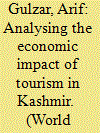

|
|
|
|
|
| Summary/Abstract |
Kashmir, often described as the Switzerland of Asia is a natural magnet for tourism with its alpine forests, balmy climate, high mountains, lakes, rushing streams, ski slopes and verdant valleys. Its rich culture and thriving handicrafts are additional assets as are its well-known pilgrimage sites. However decades of unrest and periodic military clashes between Indian and Pakistan forces have destroyed the tourist industry (even though Jammu and Ladakh have attracted a rising number of tourists) and prevented the development of the economic potential of Kashmir. This article highlights the need to restore peace and stability in the valley to bring the desired prosperity.
|
|
|
|
|
|
|
|
|
|
|
|
|
|
|
|
| 3 |
ID:
119940


|
|
|
| 4 |
ID:
151313
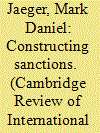

|
|
|
|
|
| Summary/Abstract |
Targeted’ sanctions seek to circumvent a target state’s citizens in general from the adverse economic impact of coercion. Arguably, this would remedy some of the population’s incentives to engage in the well-known “rallying-around-the-flag”. Yet occasionally, targeted sanctions still seem to produce such an effect. This paper explores sanctions conflicts as social constructs. It purports that rally-around-the-flag is all but one part of the discursive dimension of sanctions conflicts. Sanctions are intricately connected with the conflict setting they occur in. The study suggests a dialectical relation between how opponents perceive conflicts and the meaning of sanctions therein. This nexus of different constructions of sanctions moreover extends to “targeted” sanctions as well: As restrictive measures against Zimbabwe demonstrate, they are not the kind of minimally-invasive operations with clinical precision as such reasoning would suggest. Whether sanctions are really “targeted”, sparing the economy and concentrating on the culprits, is as much a question of discourse in the target state.
|
|
|
|
|
|
|
|
|
|
|
|
|
|
|
|
| 5 |
ID:
132497
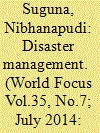

|
|
|
|
|
| Publication |
2014.
|
| Summary/Abstract |
Hundreds of Natural disasters take place worldwide every year causing irreparable damage to life and property. Earthquakes, ?oods, typhoons, hurricanes,- Tsunamis are among the worst of these natural disasters. Over the last few decades, there has been an alarming increase in the occurrence of natural disasters and the magnitude of their social, economic and environmental impact. During any natural disaster it is usually the" children who suffer the most. The nation witnessed the death of nearly a thousand children during the 2001 Bhuj earthquake. Out of them, 300 died while marching for the Republic day parade. They were in a narrow lane when the earthquake hit causing buildings onboth sides to collapse. It is said thatpnearly 1,884 school buildings collapsed leading to a loss of 5,950 class rooms. About 12000 schools suffered damages making them un?t for children to continue their studies. Fire tragedies, like the one in Kurnbakonam killed 93 children in a school. Another ?re accident in Dabwali, Haryana where a ?re broke out during a schoolfunction took he lives of many school children. Children in schools are the 'most vulnerable group during any disaster. These tragedies reiterate the need for all of us to sit up and think about the safety of these children. It is necessary to make schools safe and hazard proof. For this purpose, it is important to have disaster management, emergency preparedness and response plans at school level.
|
|
|
|
|
|
|
|
|
|
|
|
|
|
|
|
| 6 |
ID:
132498
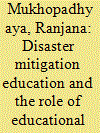

|
|
|
|
|
| Publication |
2014.
|
| Summary/Abstract |
Disasters are increasing exponentially. The number of disaster events which was 73 in 1900-09 has increased to 4494 during 2000-09. More people were affected in the two recent decades than the earlier ones. During the second half of the 20th century, more than 200 major natural disasters occurred in different parts of the world and claimed the lives of around 1.4 million people. In 2011 alone, 302 hazards resulted in disasters that claimed almost 30,000 lives, affected 206 million people and in?icted damages worth an estimated USS 366 billion, according to the United Nations Office for Disaster Risk Reduction.
|
|
|
|
|
|
|
|
|
|
|
|
|
|
|
|
| 7 |
ID:
132611
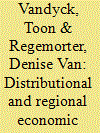

|
|
|
|
|
| Publication |
2014.
|
| Summary/Abstract |
We analyse the macroeconomic and distributional effects of increased oil excises in Belgium by combining a regional Computable General Equilibrium (CGE) model with a microsimulation framework that exploits the rich detail of household-level data. The link between the CGE model and the microlevel is top-down, feeding changes in commodity prices, factor returns and employment by sector into a microsimulation model. The results suggest that policymakers face an equity-efficiency trade-off driven by the choice of revenue recycling options. When the additional revenue is used to raise welfare transfers to households, the reform is beneficial for lower income groups, but output levels decrease in all regions. However, when the energy tax revenue is used to lower distortionary labour taxes, the tax shift is slightly regressive. In this case, national GDP is hardly affected but regional production levels diverge. The impact of the environmental tax reform on income distribution depends strongly on changes in factor prices and welfare payments, whereas sector composition is an important determinant for regional impact variation.
|
|
|
|
|
|
|
|
|
|
|
|
|
|
|
|
| 8 |
ID:
163120
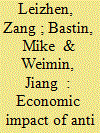

|
|
|
|
|
| Summary/Abstract |
Corruption plagues both developed and developing countries. It is a serious obstacle to China's development that is too perilous to ignore. However, conducting research on corruption, which is characterised as being the most secretive type of behaviour, is particularly difficult. Applying the vector autoregressive model (VAR) to consecutive 36-month data, the authors analyse empirically the corruption status quo and its impact in China. The authors discover short-term negative impacts of the current anti-corruption campaign in China on the economic growth of its state-owned industries, while any positive effects, e.g. improved quality of economic growth, cannot be demonstrated. The objective data used reduce significantly the confusion surrounding traditional (anti-)corruption studies, which have relied heavily on survey data or subjective evaluation.
|
|
|
|
|
|
|
|
|
|
|
|
|
|
|
|
| 9 |
ID:
154086
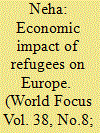

|
|
|
|
|
| Summary/Abstract |
The refugee crisis can have profound implications for Europe’s economy and society. This paper uses recent data to analyse the economic impact of refugees on Europe in terms of employment, wage rate and economic growth. The paper argues that refugees can resolve labour shortage that countries such as Germany face today.
|
|
|
|
|
|
|
|
|
|
|
|
|
|
|
|
| 10 |
ID:
160214
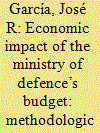

|
|
|
|
|
| Summary/Abstract |
This article analyses the economic impact of the expenditure budget of the Spanish Ministry of Defence (MoD) and its Autonomous Agencies (AA), distinguishing direct, indirect and induced effects. The input–output methodology is used to find intersectoral effects on the rest of the economy. The article quantifies the economic impact in terms of production, gross value added (GVA), employed population, tax revenue, and also in terms of its contribution to the gross domestic product (GDP) of Spain in 2010. The results show that the activity of the MoD and AA generates 1.2% of the country’s GDP and 1.7% of total employment in that year.
|
|
|
|
|
|
|
|
|
|
|
|
|
|
|
|
| 11 |
ID:
124517
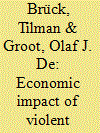

|
|
|
|
|
| Publication |
2013.
|
| Summary/Abstract |
Much of the work published in Defence and Peace Economics (DPE) significantly contributes to our understanding of the economics of conflict. Analyzing the second decade of its existence, Arce and Kollias (2010) showed that over time, the emphasis of work in DPE has shifted significantly. One rising field examines the consequences of conflict. Related to this, in 2011, DIW Berlin hosted a conference examining The Economic Impact of Violent Conflict. This special issue is the result of that conference. While this may seem like a relatively narrow area, the interpretation of that simple combination of words can be quite broad. Some of the core work in the area focuses on the calculation of the global impact of conflict (Collier, 1999, Hess, 2003, Brück, De Groot, and Bozzoli, 2012). The work of Collier (1999) has had the greatest impact and continues to do so. He focuses only on civil conflicts because of the perceived economic strengthening effects of international conflict. Collier argues that civil conflict affects growth through (i) the destruction of resources; (ii) the disruption of infrastructure and social order; (iii)
budgetary substitution; (iv) dissaving; and (v) portfolio substitution by foreign investors.
The first four of these channels are expected to influence an economy only during conflict, whereas the final one is likely to continue having a lasting effect even after the restoration of peace. This led Collier to come to his theory that the length of the conflict is going to influence the impact of the post conflict period. In particular, he argues that long-running conflicts are more likely to be followed by an increase in growth, whereas short-lasting conflicts will suffer reduced growth rates over a longer period of time (known as a legacy effect).
|
|
|
|
|
|
|
|
|
|
|
|
|
|
|
|
| 12 |
ID:
169311


|
|
|
|
|
| Summary/Abstract |
The market structure of government investment domination in the space industry is being disrupted as commercial companies began working in the commercial space sector. As the 1960s was known as a government-funded space race, the 21st century may be known as a private interest space race. U.S. policy intended to speed innovation and drive costs down by expanding the role of commercial space companies. Hence, the 2018 orbiting sports car, yet more importantly, reusable rockets, satellites, and associated services developed as a result of the deliberate shift in government policy starting with the Commercial Space Launch Act of 1984.
|
|
|
|
|
|
|
|
|
|
|
|
|
|
|
|
| 13 |
ID:
133886
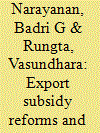

|
|
|
|
|
| Publication |
2014.
|
| Summary/Abstract |
The World Trade Organization (WTO) recommends all members to phase out their export subsidies. While this may render export-oriented industries susceptible to tighter competition in their import markets, productivity improvements could help offset such disadvantages. This article explores the interaction between these two different aspects to evaluate the economy-wide impact of export subsidy reforms and productivity improvements in the Indian textile and clothing sector. Our analysis stands on various policy simulations applying the general equilibrium model of the Global Trade Analysis Project (GTAP; Hertel, 1997). The welfare impacts of the removal of Indian textile and clothing subsidies in terms of equivalent variation shows that India is expected to encounter a loss of about 71.5 million US$, while other Asian countries may gain about 218 million US$. In a different scenario, we simulate the impact of a complete phase-out of subsidies provided to the textile and clothing industry of India and a simultaneous increase in total factor productivity growth to 3.5 per cent. This leads to a net positive welfare change and an expected gain of about US$ 13.17 million in terms of allocative efficiency. We conclude that merely removing subsidies is not enough, as is often argued by Indian policymakers that such a policy reversal might result in contraction of the sector. Investments in total factor productivity should come about simultaneously, probably by employing surplus funds from saved subsidy payments in areas like research and development and infrastructure. This conclusion may be qualitatively generalised for any sector in the world, which is examined for export subsidy reforms, but similar economy-wide studies are recommended for specific cases.
|
|
|
|
|
|
|
|
|
|
|
|
|
|
|
|
| 14 |
ID:
168334
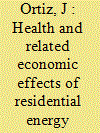

|
|
|
|
|
| Summary/Abstract |
More than 50% of the existing housing stock in Spain is over 50 years old and was built according to the construction standards of its time, and nowadays shows poor energy performance compared to the current standards, meaning higher energy consumption due to the lack of energy retrofitting interventions (no insulation materials, low window performance, high infiltration and thermal bridges). The link between homes and health has been well established by the scientific community and research results illustrate how the condition of existing buildings is one of the most decisive influences on population's health. However, the role of energy retrofitting in improving health of occupants has still to be thoroughly and comprehensively documented. Normally, benefits of energy retrofitting are calculated only in terms of energy savings and associated economic savings. Long pay-back periods and high investment make energy retrofitting not attractive enough to many homeowners. Highlighting the health benefits may help to improve the rate at which the housing stock undergoes energy retrofitting. The aim of this research is to estimate the effect that energy efficiency improvements made to vulnerable housing has on the health of the occupants and to assess the potential economic savings for the Spanish healthcare system.
|
|
|
|
|
|
|
|
|
|
|
|
|
|
|
|
| 15 |
ID:
174381
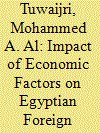

|
|
|
|
|
| Summary/Abstract |
This article attempts to further theoretical and empirical understanding of the extent to which the economic factor had been critical in determining the Egyptian foreign policy between 1978 and 2010. While the following 32 years recorded major shifts in Egypt’s domestic, regional and international affairs, the larger parameters of its foreign policy were forged in the 1970s when specific economic pressures largely determined in which direction Cairo would move. Thus, this analysis seeks to substantiate the argument that the primacy of the domestic sphere has remained recurrent. It also is contended that while economy may have been the catalyst of major foreign policy shifts in Egypt, it was indeed regime security that was—and remains—the primary determinant of the Egyptian foreign policy. The article, hence, concludes that Egypt’s foreign policy was thus determined by economic factors only to the extent that it did not endanger the security of the regime.
|
|
|
|
|
|
|
|
|
|
|
|
|
|
|
|
| 16 |
ID:
138360
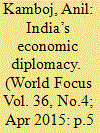

|
|
|
|
|
| Summary/Abstract |
The story of India's economic diplomacy has barely begun. For generations of Indians, the begging bowl has been an important symbol of Indian diplomacy. It is refreshing to see New Delhi now offer large credit lines across the world and help others make progress. To derive the full political benefits of economic diplomacy, the leadership will have to act decisively to break the old mind-set, which defines national security and trade policy in separate and narrow terms. If the Government can bring together the disparate strands of its economic diplomacy and give it bureaucratic coherence and political purpose, India would dramatically enhance its standing in the region and beyond in the coming years.
|
|
|
|
|
|
|
|
|
|
|
|
|
|
|
|
| 17 |
ID:
106637


|
|
|
| 18 |
ID:
184725
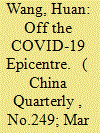

|
|
|
|
|
| Summary/Abstract |
This study documents the COVID-19 disease-control measures enacted in rural China and examines the economic and social impacts of these measures. We conducted two rounds of surveys with 726 randomly selected village informants across seven provinces. Strict disease-control measures have been universally enforced and appear to have been successful in limiting disease transmission in rural communities. The infection rate in our sample was 0.001 per cent, a rate that is near the national average outside of Hubei province. None of the villages reported any COVID-19-related deaths. For a full month during the quarantine, the rate of employment of rural workers was essentially zero. Even after the quarantine measures were lifted, nearly 70 per cent of the villagers still were unable to work owing to workplace closures. Although action has been taken to mitigate the potential negative effects, these disease-control measures might have accelerated the inequality between rural and urban households in China.
|
|
|
|
|
|
|
|
|
|
|
|
|
|
|
|
| 19 |
ID:
124925
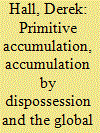

|
|
|
|
|
| Publication |
2013.
|
| Summary/Abstract |
Critical scholars have made extensive use of the concepts of primitive accumulation and accumulation by dispossession to analyse the global land grab. These concepts have been crucial to efforts to understand the land grab in terms of the creation, expansion and reproduction of capitalist social relations, of accumulation by extra-economic means, and of dispossessory responses to capitalist crises. This paper provides an overview of these approaches. It also argues that there are substantial challenges involved in the use of primitive accumulation and accumulation by dispossession, including tensions and ambiguities over what the concepts mean, the assumptions embedded within them and problems of fit with other conceptualisations of the land grab. The paper also highlights resources for engaging with these challenges in the land grab literature.
|
|
|
|
|
|
|
|
|
|
|
|
|
|
|
|
| 20 |
ID:
166391


|
|
|
|
|
| Summary/Abstract |
The shortage of traditional energy sources and environmental pollution caused by the consumption of fossil fuels have become increasingly prominent, and many countries regard the development of renewable energy as important for ensuring energy conservation and emission reductions. In addition, renewable portfolio standard is important for China to achieve energy transition. The Chinese government is actively promoting the construction of a renewable portfolio standard system. Considering different renewable energy development targets for renewable portfolio standards, this paper establishes a dynamic computable general equilibrium (CGE) model to research the impacts of achieving various policy targets. The main simulation results are as follows. Promoting renewable sources would have a slightly negative impact on macroeconomics. For each additional percentage point in the share of renewable energy generation in 2030, the loss of GDP would increase by approximately 9.11 billion RMB. A renewable energy policy could be also conducive to carbon emission reduction and energy structure adjustment. Certainly, the proportion of renewable energy in the total power generation should be approximately 34% to achieve the government target for non-fossil fuels to account for approximately 20% of the primary energy consumption by 2030.
|
|
|
|
|
|
|
|
|
|
|
|
|
|
|
|
|
|
|
|
|